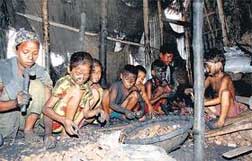|
| |
Child labour- A General
view
Main
Article page |
Beauty articles
|
Health page |
Computers|
Diseases |
Education |
Family
Fitness|
Fruits and Vegetables
|
Jobs |
General |
Personality|
Technology
|
Tourism
More Articles By Hemanth Bhaskaran

By
Hemanth Bhaskaran: Child Labour, consisting of children below 14 years of age,
is defined by the International Labour Organisation (ILO) as those types of work
performed by children that deprives them of their childhood and their dignity,
which hampers their access to education and acquisition of skills and which is
performed under conditions harmful to their health and their development.
Children are the greatest gift to humanity and the same gift is being misused
for personal gains as child labour. They constitute 36% of India's population
but a large majority of children in the age group of 5-14 years continue to
remain in distress and turmoil. One in every five children below the age of 14
is a labourer. The flower (here, child) withers before it blossoms.
Child labour is more a rural phenomenon than an urban phenomenon. Due to acute
poverty poor families residing in rural areas send their children to urban areas
for earning daily bread and butter. In urban areas, to survive in cutthroat
competition, manufacturers have lowered the real wages for adult workers in
order to employ child workers on low wages. The problem is vast with its share
of adverse wide reaching effects. Children are forced to work in the most
hazardous, unhygienic conditions, where they are vulnerable to many severe
health problems.
In
a country like India where over 40 percent of the population is living in
conditions of extreme poverty, child labour is a complex issue. The following
are some of the causes of child labour. Extreme poverty is the chief cause of
child labour. The children either supplement their parent’s income or are the
only wage earners in the family. Secondly Child labour is deliberately created
by vested interests to get cheap labour. Thirdly the illiteracy of parents is
also a major factor in determining the incidence of child labour. Fourthly a
majority of parents prefer to send their children to work rather than to school
at the school-going age, primarily on account of their need for a supplementary
income.
Child labour is a universal problem and as citizens of India we must strive to
take stern action against child labour. NGOs have an important role to play in
the elimination of child labour. The Government does not have the infrastructure
to reach every section of the society and particularly the millions who work and
live in remote areas. Thus NGOs can act as a bridge between the interior areas
and the government. The role of media in elimination of child labour is one of
the most important components of the process of total human development. The
media should expose defaulting firms or business houses that clandestinely
employ children and violate laws relating to child labour. The government should
give certain monetary or non-monetary incentives to the families that live Below
Poverty Line (BPL) to avoid child labour so that their children can be sent to
school. Effective state intervention to eliminate inequities, including class
and caste barriers to employment and other opportunities in areas such as health
and education, will put an end to child labour.
Child labour is an international evil. It requires cumulative efforts to wipe it
out. Toiling long hours for a pittance, these little breadwinners accept
exploitation as a way of life. The government on this front has also taken a few
steps. The International Labour Organization (ILO) launched the International
Programme for Elimination of Child Labour in 1991 and India was the first to
join the same in 1992. However, this critical problem persists due to poor
implementation of the plans and programmes. The need of the hour is to expand
the machinery for enforcing the various laws on child labour. There are a
plethora of laws to combat child labour but nothing can eradicate child labour
unless there is awareness among parents and children, which will go a long way
in saving the future of millions of working children in India. Lastly instead of
blaming the "supply side", we must focus on the "demand side' and control our
urges for cheap (child) labour to light up their dark lives.
Child Labour (Speech) Good morning everyone. My objective today is to talk to
you about child labour. Do you know that of every 100 children in the world
today, 16 of them are child labourers, 12 of them are in its worst form, and
many will never go to school? There are 246 million child labourers in the world
today, most are in developing countries. Some of them are as young as 5, 186
million of them are under 15 and 170 million of them are doing hazardous work
and operating dangerous tools or machineries. They are working on farms,
plantations, mines, or even construction site, breathing in noxious fumes and
exposed to harsh chemicals or dangers. Of every 100 children, more than half
will never finish school, escape poverty or even have a decent job. Let me
begin by clearly explaining the meaning of the term “child labour”. Child labour
is the employment of children under an age determined by law or custom. This
practice is considered exploitative by many countries and international
organizations. Child labour was utilized to varying extents through most of
history, but entered public dispute with the beginning of universal schooling,
with changes in working conditions during industrialization, and with the
emergence of the concepts of workers' and children's rights. So, how can we
stop child labour? We can solve these problems by improving child labour
legislation and laws and also by increasing the quality, relevance and access to
education. Many countries have national child labour laws that establish a
minimum age for work and regulate working conditions. However legal protection
for child labourers is not effective to the kinds of work children are most
involved in, such as agriculture and domestic service. In addition, labour laws
in many countries do not cover factories employing less than ten people. It is,
therefore, important to extend protection so that laws cover the main places
where children work. Education is also a key to ending the exploitation of
children. If an education system is to attract and retain children, its quality
and relevance must be improved as well. Children who attend school are less
likely to be involved in hazardous or exploitative work. They are also more
likely to break out of cycles of poverty. The main obstacle to achieving
universal primary education is only the inability and/or the unwillingness of
governments to provide quality educational facilities for poor children in rural
areas and in city shantytowns, because evidence from around the world has shown
that poor families are willing to make sacrifices to send their children to
school when it is economically and physically accessible. In conclusion, child
labour should not happen as our greatest “natural resource” is the mind of the
children. If child labour continues, the children will not be able to get a good
education and our society cannot improve. So, let’s put our hand together to
stop child labour.
| |
|




